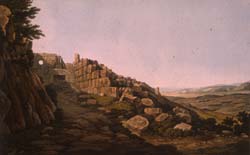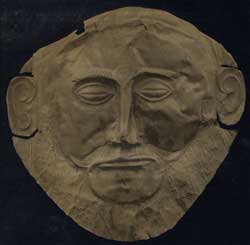Biography of Heinrich Schliemann (1822-90)
Heinrich Schliemann (1822-90) was born in what is now Germany. From an early age he was fascinated by Greek myths, particularly those connected with the story of the Trojan War, immortalised by poets like Homer (eighth century BC) in his two epics, the Iliad and the Odyssey. The Iliad tells the story of the anger of the Greek warrior Achilles at Ilion, or Troy; the Odyssey recounts the adventures of Odysseus on his way home from Troy to the island of Ithaka. The Trojan War began when Helen, wife of Menelaos, king of Mycenae, was abducted by Paris, a prince of Troy.
Schliemann was convinced that these stories were not mere myths, but that some kind of reality lay behind them. He grew up determined to prove Homer right. Schliemann went into business, and was successful enough to pursue his archaeological interests full-time in his later 40s.
 The Lion Gate, Mycenae by Edward Dodwell (1834). |
His method was very simple: like the classical historians who preceded him, he used surviving ancient place names in order to locate places to excavate. His first serious archaeological work focussed on Ithaka, and later he excavated some trenches there, but he is remembered more for his excavations at Ilion (1870-3, 1878-9, 1882, 1890), and at Mycenae (1874, 1876, 1881), whose names had never been lost. Indeed, at Mycenae there had always been significant remains above ground such as the massive fortification walls entered through the Lion Gate and the large tomb known as the Treasury of Atreus.
 ‘The mask of Agamemnon’. Height 26 cm. © Harry N. Abrams |
At Troy/Ilion, Schliemann excavated a city in levels; he was sure that Level II was the Ilion of the Iliad. At Mycenae, Schliemann excavated five tombs full of rich grave goods, now known as the Shaft Graves of Grave Circle A. When a gold mask showing a serious bearded face was revealed, Schliemann thought that he had gazed on the face of Menelaos' brother Agamemnon.
Later scholarship has shown that it is Level VI at Troy that is contemporary with the Shaft Graves of Mycenae, and that these graves in turn are earlier than the Lion Gate and the fortification walls. It has also shown that the story of the Trojan War as told by poets like Homer may never have been an accurate reflection of a particular time and place.
But Schliemann's greatest achievements remain crucially clear. First, he revealed once and for all that there was an important 'time before' in the Aegean - a prehistoric period with its own complex societies, complete with large-scale monuments and long-distance connections. Second, he realised that monuments alone were not enough for dating these newly discovered stretches of time, and that pottery could furnish a way of constructing an accurate relative chronology. (See relative dating.)